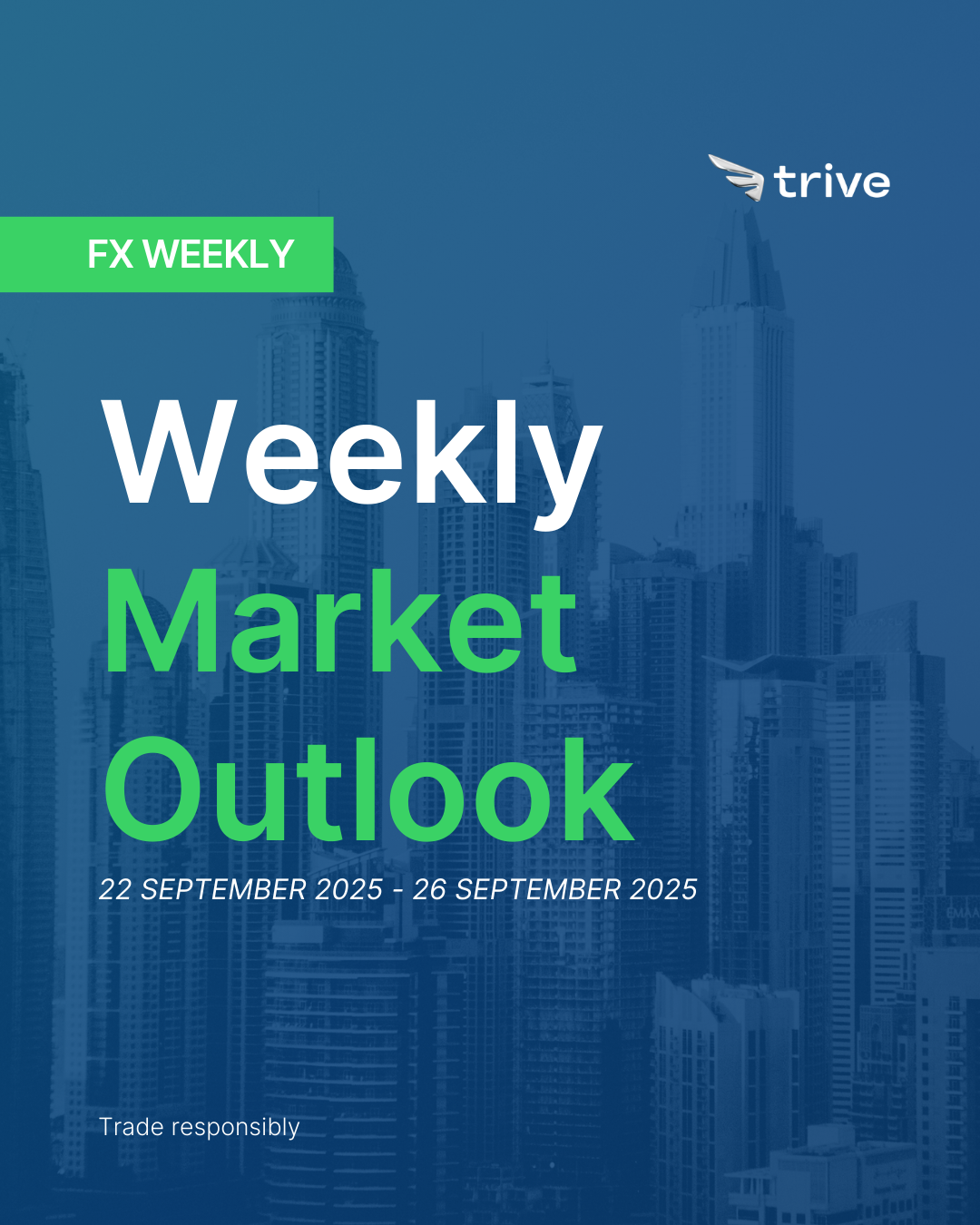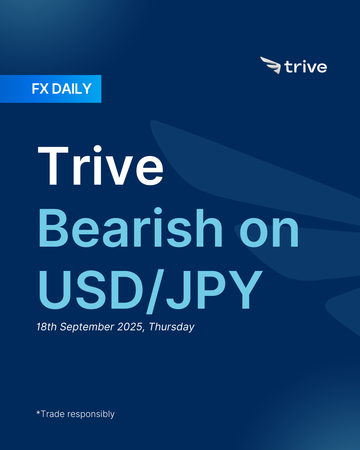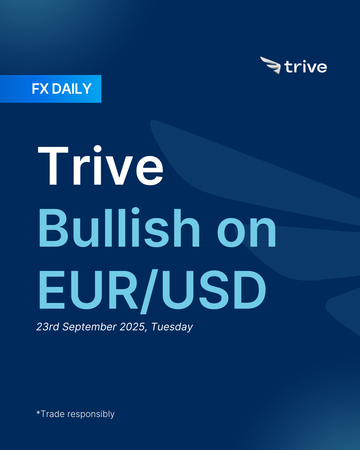FX Weekly: Trive’s Week Ahead Views

This week highlights include US PCE data, SNB rate decision, Flash PMIs, and inflation reports from Australia and Tokyo.
Monday
According to a Reuters survey of 20 analysts, the People’s Bank of China is widely expected to keep its Loan Prime Rates unchanged for the fourth consecutive month, holding the 1-year and 5-year rates steady at 3.00% and 3.50%, respectively. This follows the central bank’s decision to maintain the seven-day reverse repo rate after the Federal Reserve’s recent 25bps cut. Officials have previously signalled that any shift in the LPR would follow a change in the key policy rate.
Recent economic data has highlighted broad weakness, prompting calls for further stimulus. However, market participants cited by Reuters believe that resilient exports and a rally in domestic equities have reduced immediate pressure for action. Even so, some desks still flag a small chance of a surprise move. Macquarie expects incremental easing measures later this year to help secure the government’s “around 5%” growth objective, projecting a possible 10bp rate cut before year-end. Barclays remains more cautious, suggesting that the scale of fiscal support could stay limited if the current US-China trade truce continues.
Tuesday
Ahead of the upcoming Riksbank decision, there is no firm newswire consensus. Analysts at SEB forecast a 25bps cut in the policy rate to 1.75% from the current 2.00%. However, SEB’s own survey indicates that 64% of respondents anticipate the central bank will leave rates unchanged in September, expecting a cut instead in November. At the previous meeting, the Riksbank kept rates on hold, as expected, and maintained that there was still some probability of another rate reduction this year, consistent with its June projections.
Turning to the data backdrop, August core CPIF inflation eased to 2.9% Y/Y from 3.2%, below the forecast of 3.1%. SEB notes that while inflation remains relatively high, the figures suggest the Riksbank’s assessment that the summer’s uptick was driven by temporary factors was likely accurate. Economic indicators show ongoing weakness, though some tentative signs of recovery have emerged: unemployment eased slightly to 8.7%, GDP remains subdued, and consumer confidence has begun to improve. SEB therefore leans towards a 25bps cut, arguing that softer inflation supports such a move. In contrast, Nordea highlights still-elevated inflation and the recent recovery in economic activity as reasons to keep policy unchanged. Looking ahead, attention will centre on the updated rate path. The current Monetary Policy Report for Q4 2025 implies some possibility of another cut, and if a September cut is delivered, markets will be watching the guidance for Q1–Q2 2026, which currently sits at 1.88%.
For September, market expectations are for the Eurozone’s manufacturing PMI to edge higher to 51.0 from 50.7, services to remain steady at 50.5, and the composite to climb to 51.2 from 51.0. In the prior release, the composite PMI moved further into expansion territory, reaching a one-year high. Oxford Economics observes that the upcoming data “should offer a more complete picture of what growth looked like during Q3”. They anticipate a modest improvement, but caution that current PMI levels still signal only weak GDP growth. They also see manufacturing showing slightly more strength than services, though both remain near the 50-point threshold, reflecting weak growth in both sectors. From a policy perspective, with the ECB keeping policy unchanged earlier this month and signalling that inflation is aligned with its medium-term target, the data would need to weaken sharply to revive prospects of further rate cuts. For now, markets are pricing in only 4bps of easing by year-end.
September expectations call for the UK services PMI to fall to 53.9 from 54.2, manufacturing to dip slightly to 46.9 from 47.0, and the composite to ease to 53.0 from 53.5. Last month’s release showed the August composite extending further into expansion thanks to a notable lift in services. The report indicated that economic growth had accelerated over the summer after a sluggish spring, reaching a one-year high. Investec expects manufacturing PMI to remain broadly unchanged, citing caution ahead of the November budget. For services, the firm foresees potential fiscal concerns weighing on sentiment, projecting a drop to 53.5, leaving the composite at 53.0. Investec also warns that such a result “would not necessarily carry a strong message for official value-added data”, highlighting the imperfect correlation between composite PMI readings and month-on-month GDP growth. In terms of policy, with inflation expected to rise to 4% in September, this release is unlikely to meaningfully alter BoE easing expectations. Markets currently price only an 8% chance of a 25bps cut in November as policymakers wait for the Autumn budget later in the month.
Wednesday
The August Monthly CPI Indicator is expected to increase to 2.9% Y/Y from 2.8%, while Westpac forecasts a slightly stronger 3.1% rise, citing base effects. In July, CPI surprised to the upside at 2.8% Y/Y (vs. 2.7% expected), driven by a 0.9% M/M gain led by electricity, new dwellings, and holiday travel.
For August, Westpac notes that electricity prices in New South Wales and the Australian Capital Territory are set to ease as government rebates take effect, partly offsetting further increases in other regions. The bank estimates a 3% rise in power prices overall. Westpac expects headline CPI to climb only 0.1% M/M, which would lift the annual pace to 3.1% Y/Y. The bank adds that “there is a high degree of uncertainty, with the recovery in homebuilders’ margins a notable upside risk.”
Thursday
The Swiss National Bank is expected to keep its policy rate unchanged at 0.0%, following the cut to the zero lower bound in June. August inflation matched market forecasts with Y/Y at 0.2% (prev. 0.2%), in line with the 0.1% average the SNB anticipated for Q3. While inflation is running slightly hotter than the Bank’s forecast, the August M/M reading of -0.1% is not a cause for concern, as similar monthly declines have occurred in recent months without prompting action.
Notably, Chairman Schlegel has stated that the threshold to move rates into negative territory remains high, but the SNB would act if absolutely necessary. He also noted that the apparent real appreciation of the CHF is less significant once global price dynamics are taken into account. The prevailing expectation is for rates to stay at 0.00%, with market pricing suggesting only a 5% chance of a move into negative territory. Attention will shift to the December meeting to assess how the inflation outlook has evolved, though many desks now believe the SNB has reached its terminal rate.
Friday
Currently, no forecasts have been released for the upcoming Tokyo CPI, which typically serves as a leading indicator ahead of the nationwide figure. In the previous month, Tokyo CPI stood at 2.6% Y/Y, with Core CPI at 2.5% Y/Y and the “super core” at 1.5% Y/Y. This release will be closely watched before the BoJ’s October 30th policy meeting, especially after Governor Ueda stressed the importance of monitoring the economic impact of U.S. tariffs. He has repeatedly noted that Japan’s economy is so far absorbing the effects of the tariffs.
On inflation, Ueda pointed out that the recent rise in food prices, particularly rice, is expected to fade, and while underlying inflation remains below the 2% target, it is moving closer to that level. He highlighted the need to carefully track household inflation expectations, though he does not consider the recent dip in short-term expectations to be troubling. Ueda added that the latest CPI figures align with the Bank’s outlook and that while food price inflation is unlikely to significantly affect underlying price trends, risks remain. He also acknowledged that higher inflation can hurt household livelihoods, underscoring the need for continued vigilance.
Following the August PPI and CPI reports, analysts projected that Core PCE would rise between 0.28% and 0.35% M/M (vs. 0.27% in July), according to the Wall Street Journal’s Fed watcher Nick Timiraos. He highlighted that in August the gap between core PCE and core CPI widened, as prices in items with higher PCE weightings fell even while core CPI rose.
Fed Chair Powell indicated that headline PCE is expected at 2.7% Y/Y in August (vs. 2.6% in July), noting that goods inflation contributed between 0.3–0.4 percentage points to PCE inflation. Powell expects core PCE for August to print at 2.9%. At its latest policy meeting, the Fed maintained its median projection for headline PCE at 3.0% in 2025, but raised its 2026 forecast to 2.6% from 2.4%, keeping 2027 at 2.1%. For core PCE, the Fed kept its 2025 view at 3.1%, sees it easing to 2.6% in 2026 (vs. 2.4% in June), and then reaching 2.1% in 2027.
Barclays analysts wrote that “with core PCE inflation likely to print around 0.21% M/M for August, such projections imply that the median FOMC participant expects core PCE inflation to accelerate to around 0.27% M/M from September to December, likely as a result of tariffs.” The bank also noted that officials’ decision to raise inflation projections for 2026 likely reflects expectations of more persistent tariff-related inflation pressures. The FOMC anticipates inflation will return to its 2% target in 2028. Additionally, the Fed’s September policy statement reiterated its attentiveness to risks on both sides of its dual mandate, but added that “downside risks to employment have risen,” signalling that policymakers are shifting some focus toward the labour market rather than solely on inflation.
Disclaimer
This material is provided for informational purposes only and does not constitute financial, investment, or other advice. The opinions expressed in this material are those of the author and do not necessarily reflect the views of Trive International. No opinion contained in this material constitutes a recommendation by Trive International or its author regarding any particular investment, transaction, or investment strategy. This material should not be relied upon in making any investment decision.
The information provided does not consider the individual investment objectives, financial situation, or needs of any specific investor. Investors should seek independent financial advice tailored to their individual circumstances before making any investment decisions. Trive International shall not be liable for any loss, damage, or injury arising directly or indirectly from the use of this information or from any action or decision taken as a result of using this material.
Trive International may or may not have a financial interest in the companies or securities mentioned. The value of investments may fluctuate, and investors may not get back the amount they originally invested. Past performance is not indicative of future results.
For more information about Trive International, please visit http://trive.com/int
Additional Information
Investing involves risk, including the potential loss of principal. Diversification and asset allocation strategies do not ensure a profit or guarantee against loss. The content in this material is subject to change without notice and may become outdated or inaccurate over time. Trive International does not undertake any obligation to update the information in this material.
By accessing this material, you acknowledge and agree to the terms of this disclaimer. If you do not agree with these terms, please refrain from using this information.
कोई टिप्पणी नहीं
Home
Trive
TriveHub





0 टिप्पणियाँ